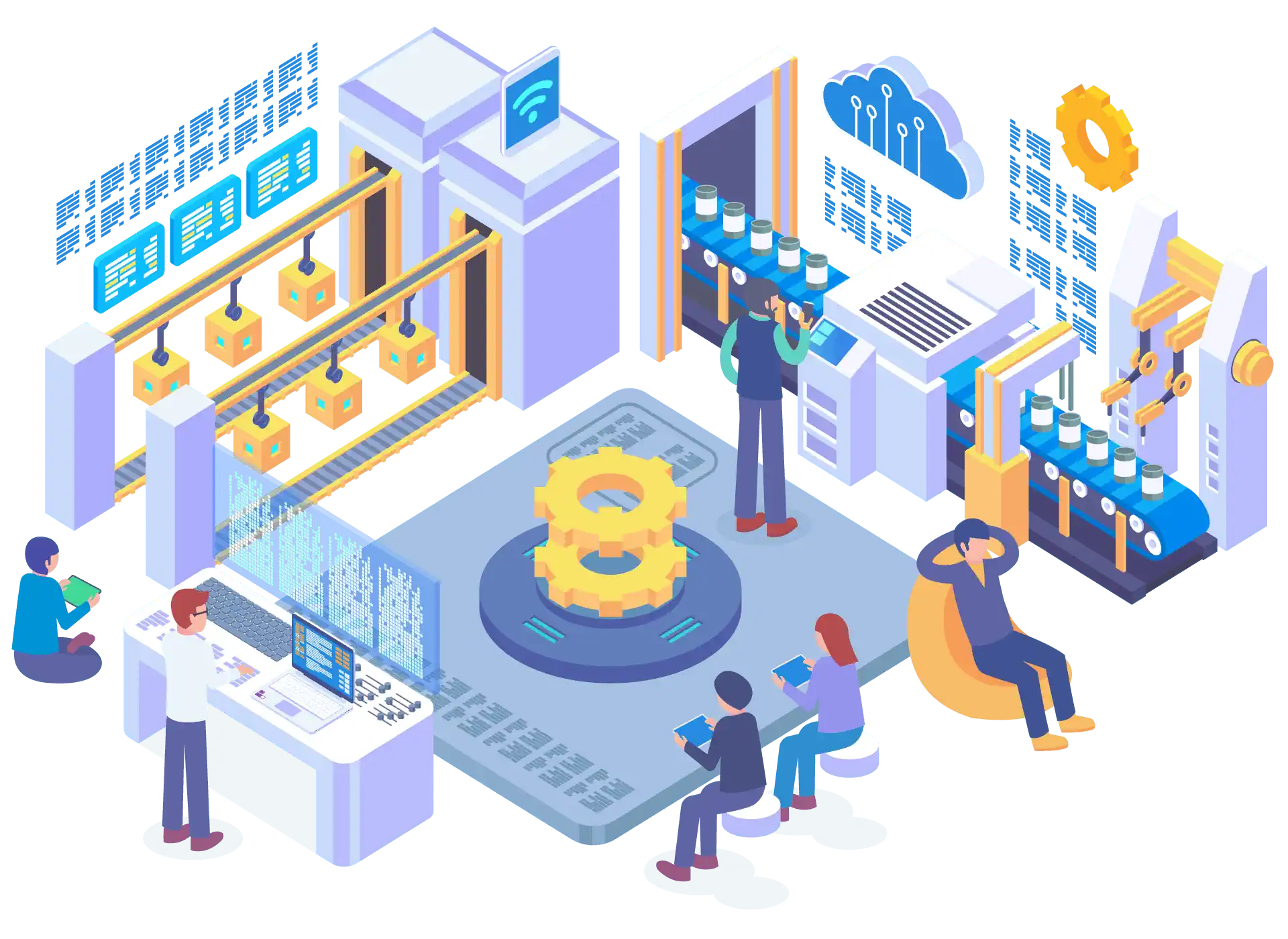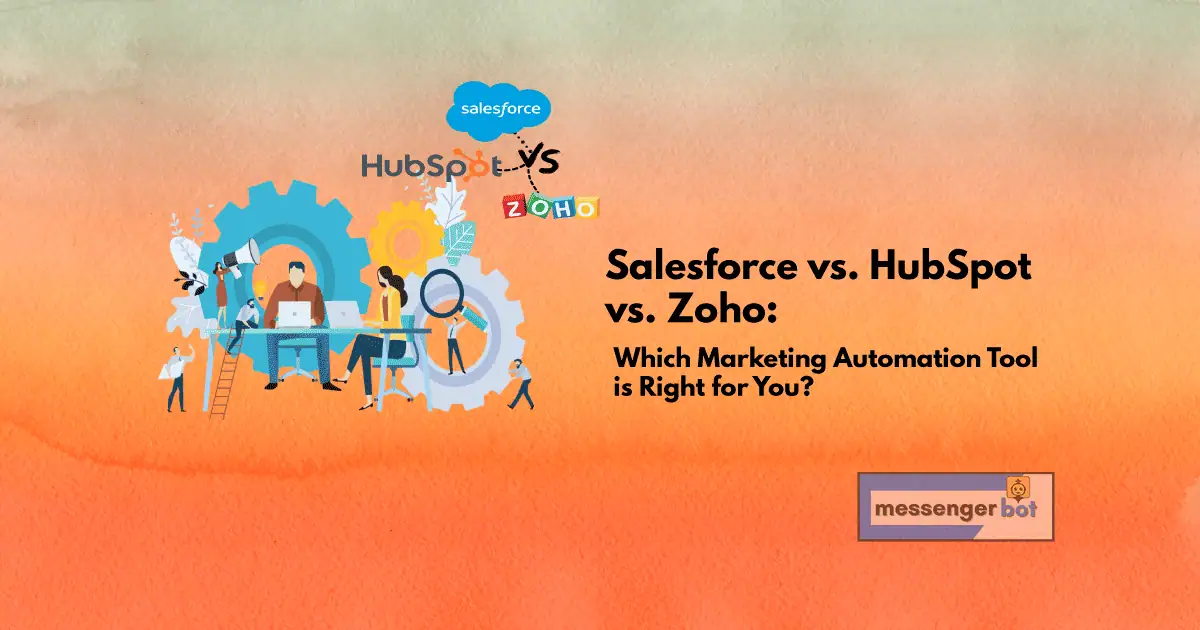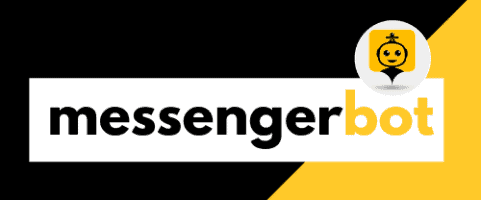Salesforce vs HubSpot vs Zoho: Marketing automation is one of the most important things you can do to grow your business. But which marketing automation platform should you use? Salesforce, HubSpot, or Zoho?
The answer is not as simple as it seems. Each company has its advantages and disadvantages, but there are a few key points that will help you decide which tool may be best for your business.
What does CRM software do?

CRM software is designed to organize and track your company’s interactions with current and prospective customers.
CRM software is used to keep track of all your contacts and important customer information.
It can also help with managing marketing campaigns, making sales forecasts, and organizing client data.
CRM software typically has a dashboard that includes information such as leads, opportunities, contacts, and customer history.
Most CRMs have built-in contact management tools to help you keep tabs on all of your customers with details about their company, title, location, and more.
How to Decide What the Best CRM Software Is

A good CRM software should be able to give you access to all of your customer information and data in one place. It should help you manage your sales pipeline, identify key opportunities and create effective campaigns. It should also be easy to use and adaptable.
HubSpot vs Salesforce vs Zoho Features Comparison
Marketing automation tools are becoming an increasingly important part of any organization’s marketing strategy.
They offer a wide range of features to help businesses automate their marketing tasks and processes.
But which tool is right for your business?
Here’s a comparison of HubSpot, Salesforce, and Zoho – three of the most popular marketing automation tools on the market.
Team collaboration and integration

Team collaboration and integration are important to marketing because many of the tasks that are done by marketers today require more than one person. Whether it’s a designer, developer, or copywriter – using tools that allow you to collaborate with your team is extremely valuable for businesses.
Team collaboration is defined as the group effort of two or more people who work together to achieve a common goal. It is important because it helps marketers accomplish their tasks faster and easier than they would be able to if working alone.
Integration is defined as the process of incorporating one or more things into a larger system. It’s important because it allows marketers to work with and access data from other tools they may be used without having to copy and paste information which can lead to mistakes being made.
HubSpot helps teams collaborate and integrate by allowing users to share tasks with other team members. You can also add notes, files, or comments that allow multiple people to work on a project at once in real-time. In addition, HubSpot has integrations with tools such as Google Drive which allows marketers to easily create documents for their projects all from within the platform itself.
HubSpot also offers a built-in chat feature that lets team members communicate with each other in real-time. This is a great way to get quick feedback on projects or to ask for help when you need it.
Salesforce differs from HubSpot in that it offers a more closed system. With Salesforce, team members can only share tasks with other users who are also on the same account. This can be limiting for some businesses as they may want to collaborate with people outside of their company.
Salesforce also doesn’t have native integrations with other tools as HubSpot does. However, many third-party integrations are available which allow users to connect their Salesforce account with other tools they may be using.
Zoho offers a similar set of tools to HubSpot in terms of team collaboration and integration. Users can share tasks with other users who are also on the same account, add notes or files to projects, and communicate with each other via chat if needed.
Zoho is different from HubSpot because it doesn’t offer native integrations such as Google Drive (with HubSpot) or Salesforce (with HubSpot). However, third-party integrations are available which allow users to connect their Zoho account with other tools they may be using.
In terms of team collaboration and integration, HubSpot is the clear winner. Its tools make it easy for users to share tasks with other team members, add notes or files to projects, and communicate with each other in real-time. It also has integrations with many other tools which allows marketers to work with data from other sources without having to copy and paste information.
Salesforce offers similar features to HubSpot, but its system is more closed off. Team members can only share tasks with other users who are also on the same account which can be limiting for some businesses. It also doesn’t have native integrations with other tools.
Zoho offers similar features to HubSpot and Salesforce, but it doesn’t have as many integrations. Third-party integrations are available, but they do not allow users to connect their Zoho account with other tools as natively as HubSpot and Salesforce.
Reporting and analytics

Reporting and analytics are two of the most crucial elements that help you determine your marketing efforts’ success or failure. It is important to know which efforts are working and which ones aren’t so you can focus your time on the former.
Reporting and analytics are especially important for marketing automation tools because they take a lot of trial and error to get right.
HubSpot has one of the most comprehensive reporting features among marketing automation tools. It offers detailed reports on traffic sources, engagement metrics, social media activity, and conversions.
The free version allows you to track up to 100 contacts across 20 different activities for each lead or contact including website visits, emails opened/clicked and phone calls made. The full suite plans which start at $200/month offer more features like A/B testing, custom reports, and advanced filters.
Salesforce doesn’t provide extensive reporting and analytics because it is primarily a CRM tool. However, its lead scoring feature allows you to automatically track the engagement level of your leads so that sales reps are aware if their prospects are ready for sales or not.
Salesforce also integrates with a number of third-party analytics tools like Google Analytics, Mixpanel, and Tableau.
Salesforce’s reporting and analytics features are much more limited than Hubspot’s.
Zoho offers a lot of detailed reports on marketing campaigns, website visitors, lead conversions, and email opens/clicks. It also offers A/B testing for emails and landing pages.
However, it does not have the comprehensive reporting features that HubSpot and Salesforce offer. Additionally, its integrations with third-party analytics tools are limited to Google Analytics.
Zoho’s reporting and analytics are most similar to Salesforce’s since it doesn’t offer detailed reports on traffic sources, engagement metrics, or social media activity.
In terms of reporting and analytics, HubSpot is the best option for marketing automation tools. Its free plan offers detailed reports on traffic sources, engagement metrics, and social media activity whereas its full suite plans offer additional features like A/B testing and custom reporting. Salesforce is the best option for CRM tools and its lead scoring feature allows you to automatically track the engagement level of your leads. Zoho offers a lot of detailed reports on marketing campaigns, website visitors, lead conversions and email opens/clicks but its integrations with third-party analytics tools are limited.
Scalability

Scalability is the ability of a system, network, or process to handle a growing amount of work. Marketing automation platforms are software systems that automate tasks traditionally performed by marketers and sales teams with special applications like email marketing, social media management tools, lead nurturing programs, etc. Since these systems reach out to prospects on behalf of your business you want them to be scalable so they can keep up with the increasing number of leads and customers.
Scalability is often considered a function of software architecture.
Hubspot’s platform is very scalable. Hubspot’s architecture allows you to add unlimited users, contacts, and companies without any performance degradation or added costs. Hubspot can also handle increased loads of data by using a distributed caching system.
Hubspot’s scalability has been tested and proven in the real world. The company has more than doubled in size every year for the past six years, and its marketing automation system has handled that growth without any problems.
Hubspot’s scalability feature is also being constantly improved. Hubspot released the Hubspot Application Programming Interface (API) in 2010 to give developers the ability to create applications that integrate with its marketing automation system. The company has also created a developer community around its API so developers can share tips and tricks for making the most of Hubspot’s scalability.
Salesforce is a bit more complex to scale than Hubspot. Salesforce is designed for large, multinational businesses with thousands of users and contacts. Hubspot is better suited for small and medium-sized businesses.
Salesforce has been scaling successfully for many years now. It can handle increases in load by adding new servers or clusters to its architecture as needed.
Salesforce also offers a suite of tools called the Sales Cloud that helps sales teams manage their leads and customers. The Sales Cloud is scalable and can handle large amounts of data.
Zoho is very simple to scale. It is designed for small and medium-sized businesses that don’t have many users or contacts.
Zoho’s scalability feature is also being constantly improved. Every year Zoho releases a new version of its software with performance improvements, bug fixes, security updates, etc., so it gets better over time without any additional effort from users.
Zoho offers a wide range of reporting and analytics features that are suitable for small businesses. The company has also been scaling successfully for many years now. It can handle increases in load by adding new servers or clusters to its architecture as needed.
In terms of scalability, Hubspot is the clear winner. It can handle unlimited users, contacts, and companies without any performance degradation or added costs. Hubspot also has a distributed caching system that ensures its platform can handle increased loads of data.
Salesforce is a bit more complex to scale than Hubspot but it can handle large amounts of data due to its Sales Cloud suite of tools. Salesforce has also been scaling successfully for many years now.
Zoho is very simple to scale and it can handle increases in load by adding new servers or clusters as needed. Zoho’s scalability feature is being constantly improved every year with the release of a new version that includes bug fixes, security updates, etc. Zoho also offers a wide range of reporting and analytics features that are suitable for small businesses.
Pricing
Pricing is an important factor when considering a marketing automation tool. Salesforce is the most expensive option, followed by HubSpot and then Zoho. All three have different pricing models, so it’s important to understand which one would work best for your business.
Pricing is defined as the process of deciding what something is worth in terms of its value.
HubSpot’s pricing is based on the number of contacts you have in your database. The more contacts you have, the more expensive it becomes. Salesforce and Zoho both charge by the number of users you have.
Hubspot also offers a free trial so you can test out the tool before deciding if it’s the right fit for your business. Also, keep in mind that HubSpot has a wide variety of features, so the price may be worth it depending on your needs such as webinars, events, and contests.
Salesforce’s pricing is based on the number of contacts and users you have in your database. It also offers a free trial, but it’s important to note that Salesforce is more expensive than HubSpot.
Salesforce has a wider variety of features than HubSpot, so if you need access to all of those features, then the price may be worth it. It is important to note that Salesforce has a wide range of features, so the price may be worth it depending on your needs such as reporting and customer service requests.
Zoho’s pricing is based on the number of users you have. Zoho also offers a free trial and it does not require contracts, which means that you can cancel at any time without penalty or fees.
Zoho has fewer features than HubSpot and Salesforce but still has enough to meet your needs such as reporting, lead scoring, and email marketing automation. Zoho also offers integration with Google Analytics, which is a bonus.
In terms of pricing, HubSpot is the most affordable option, followed by Salesforce and then Zoho. Keep in mind that HubSpot offers a free trial so you can test out the tool before deciding if it’s the right fit for your business. If you need access to all of HubSpot’s features, then the price may be worth it.
Salesforce is more expensive than HubSpot, but it has a wider variety of features. If you need access to all of those features, then the price may be worth it depending on your needs such as reporting and customer service requests.
Zoho is the cheapest option out of the three with pricing based on user numbers rather than the number of contacts or users like Salesforce and HubSpot. Zoho also offers a free trial so you can test out the tool before deciding if it’s the right fit for your business. If you need access to all of Zoho’s features, then the price may be worth it.
In conclusion, when considering a marketing automation tool, pricing is an important factor to consider.
Customer support

Customer support is important in marketing because it helps to keep customers happy and engaged. Happy, engaged customers are more likely to remain loyal to your brand and recommend you to others. Customer support can be provided through a variety of channels, including email, phone, chat, or social media.
Customer support is defined as the provision of assistance to customers who have questions or problems with a product or service. It can include anything from answering customer inquiries to resolving complaints.
Hubspot provides excellent customer support. Customers can call, email, or chat with a representative. Representatives are available around the clock and there is always someone working to answer questions for customers.
Hubspot’s customer support is available through phone, email, and chat. Hubspot is also known for its excellent documentation which provides users with all the information they need to get started quickly.
Salesforce is different than HubSpot in terms of customer support. Salesforce does not offer phone or chat assistance, but they do have an extensive library of well-written documentation that is searchable by keywords and phrases to help users solve problems on their own.
Salesforce’s customer support is available through email only. However, representatives are available 24/11 and usually reply to emails within a few hours.
Zoho’s customer support is different than HubSpot and Salesforce. Zoho offers phone, email, and chat support. Representatives are available 24/365 and usually reply to emails within a few hours.
Zoho’s customer support is available through all three channels – phone, email, and chat. They also have an extensive library of well-written documentation that is searchable by keywords and phrases to help users solve problems on their own.
In terms of customer support, HubSpot, Salesforce, and Zoho all offer similar options such as phone, email, and chat support. However, HubSpot’s customer service is available around the clock while both Salesforce and Zoho are only available during certain hours. Additionally, Hubspot has an excellent reputation for providing quality customer support while Salesforce’s customer service is sometimes criticized. Zoho’s customer service is praised for being quick and helpful, but some users have reported a lack of phone availability.
Automation

Automation is the use of software and computer systems to complete tasks that would be time-consuming or otherwise impossible for a human alone. Marketing automation is used in marketing to automate many different processes such as email, customer relationship management (CRM), social media, and website analytics tracking.
Automation is important in marketing because it allows marketers to save time and effort by automating repetitive tasks. Automation also allows for more efficient and effective communication with customers, which can lead to better customer relationships and increased sales.
Hubspot is a popular marketing automation tool that allows users to automate many different tasks such as email, customer relationship management (CRM), social media, and website analytics tracking. Hubspot also offers a wide range of features such as lead scoring, contact insights, and A/B testing.
Hubspot’s automation features are designed to help users save time and effort by automating repetitive tasks. Hubspot also offers a wide range of features such as lead scoring, contact insights, and A/B testing that can help marketers improve their marketing campaigns.
Salesforce differs from Hubspot in that it offers much fewer automation features. Salesforce focuses more on sales and therefore has tools such as lead scoring, contact insights, and A/B testing for marketing purposes.
Salesforce’s focus is not entirely on marketing like HubSpot but this does allow them to offer a suite of other useful business management apps including CRM, resource management, and time tracking so marketers don’t have to rely solely on automation.
Salesforce’s automation features are less comprehensive than HubSpot’s, but they offer a wide range of features that can help sales teams manage their sales processes more effectively.
Zoho differs from HubSpot and Salesforce in that it offers even fewer automation features than Salesforce. Zoho instead focuses on providing a wide range of business apps that can help users manage their businesses more effectively.
Zoho’s lack of automation features may be seen as a disadvantage by some users, but this allows them to provide a suite of other useful business management apps including CRM, resource management, and time tracking so marketers don’t have to rely solely on automation.
Zoho’s focus is not entirely on marketing like HubSpot but this does allow them to offer a suite of other useful business management apps that can help sales teams manage their sales processes more effectively.
In terms of automation, HubSpot offers the most comprehensive set of features, followed by Salesforce and then Zoho. However, it is important to note that HubSpot’s automation features are designed mainly for marketing purposes, while Salesforce’s focus is on sales, and therefore their automation features are more suited for sales teams. Zoho offers the least amount of automation features but they do provide a suite of other useful business management apps.
Ultimately, the decision of which marketing automation tool is right for you depends on your needs and what you are looking to achieve with your marketing campaigns. All three tools offer different features and it is important to choose the tool that best suits your individual needs.
Ease of use
Ease of use is the ability of a website to not only look good but also be easy to navigate, intuitive, and simple. If your site is difficult for people to use or lacks the features they need it will result in lower conversions which means less revenue. Marketing automation tools need to be easy to use because a user can’t take advantage of the features they aren’t aware that exist.
Hubspot is a no-brainer to use once you become familiar with the platform. It has features that help users design, send and track emails as well as manage contacts without having to leave your browser tab if they aren’t using Salesforce.
Hubspot’s ease of use may be attributed to its simple and organized user interface. Users can drag-and-drop content blocks, create custom workflows and manage their contacts all in one place.
Salesforce is notoriously difficult to navigate for first-time users but offers a wealth of features for those who are willing to invest the time to learn. It can be used to manage your contacts, create and send emails, track website visits, and more.
While Salesforce may require a little more work upfront to learn its ins and outs, its features are hard to beat for users who want total control over their marketing campaigns.
Zoho is similar to Hubspot in that it is easy to use and has a lot of features. It also offers users the ability to drag-and-drop content blocks, create custom workflows and manage their contacts all in one place.
Zoho’s ease of use may be attributed to its simple and organized user interface. Users can drag-and-drop content blocks, create custom workflows and manage their contacts all in one place.
In terms of ease of use, Hubspot, Salesforce, and Zoho are all fairly comparable. They all offer users the ability to drag-and-drop content blocks, create custom workflows and manage their contacts all in one place. However, Hubspot is likely to be the easiest for those who are not familiar with marketing automation tools as it has a very intuitive interface. Salesforce is designed for users who want total control over their marketing campaigns but it will take some time to learn. Zoho may be the most difficult of these three tools to use because there are no pre-made workflows or templates that can help you get started quickly.
User experience
User experience is how a person feels when using a product or service. It encompasses all the aspects of using a product, from the initial contact with marketing materials to signing up for an account and using the product. Good user experience is important in marketing because it can make people more likely to buy your product or use your service. If the process is confusing or difficult, for example, people may become frustrated and give up. If the process is simple and easy to use, on the other hand, they’re more likely to be satisfied with it and proceed successfully through all stages of purchase or signing up. User experience can also affect referrals; if someone feels good about using your product or service, he may recommend it to his friends.
Hubspot is known for its user-friendly interface and easy-to-follow steps. It’s often cited as a favorite among users, partly because of the pleasant experience it provides. The company has invested heavily in making sure that its software is not only effective but also delightful to use.
Hubspot’s user experience is largely positive, but there are some common complaints. Some users have trouble importing existing contacts into the contact database–a basic function that should be intuitive enough not to require any formal training. Others complain that it’s difficult or time-consuming to figure out how to apply automation rules in Hubspot when you’re just starting because of the sheer number of options available.
Salesforce is also known for its user-friendly interface, but it’s not as widely praised as Hubspot. One reason may be that the company has been around longer and has more features, which can make it seem more complex to newcomers. However, Salesforce is highly customizable and offers a lot of options for users who want to fine-tune their experience.
Salesforce’s user experience is generally positive, but there are some areas where it falls short of Hubspot. One common complaint is that the interface can be overwhelming for beginners; in particular, there’s a lot of information presented on each page and it can be difficult to know where to start. Additionally, some users find the process of setting up automated email sequences or tasks cumbersome and time-consuming.
Zoho is the only other marketing automation tool that matches Hubspot’s user-friendliness. It has a simple, streamlined interface but still offers many of the same features as Hubspot or Salesforce. The transition from Zoho to Hubspot might be difficult for users who are accustomed to Zoho because it lacks some of the more complex functions available in those other products.
Zoho’s user experience is universally praised. There are no major complaints about the interface or the process of using the product. Many users say that it’s one of the easiest marketing automation tools to learn and use.
In terms of user experience, Hubspot, Salesforce, and Zoho are all solid products. Hubspot is widely acknowledged as the most user-friendly of the three, but it’s not necessarily better if you’re looking for something more customizable or that offers a lot of features. If you need an intuitive marketing automation tool with lots of functions available to help boost your company’s productivity, Hubspot is the best option. If you’re looking for something simpler that still offers a lot of features, Zoho is a great choice. And if you want the most user-friendly interface with little hassle, go with Salesforce. Whichever tool you choose, make sure to take advantage of the free trials available so that you can try them out for yourself and see which one works best for your business.
Mobile accessibility
Mobile accessibility is the ability of a website or app to be used by people with different disabilities. This includes blindness and low vision, color blindness, deafness and hearing loss, learning disabilities, cognitive limitations, and physical disabilities.
Mobile accessibility is important in marketing because it ensures that all potential customers can access your content. If your website or app is not accessible, you are missing out on a large segment of the population.
Make sure to test your website or app for mobile accessibility to ensure that everyone can enjoy your content. You may need to hire a specialist to help you with this.
Hubspot is one of the most accessible marketing automation tools available. It has a wide range of features that make it easy for people with disabilities to use.
Hubspot also offers a wide range of support for people with disabilities. You can access help articles, videos, and webinars to learn more about how to make your website or app accessible.
Hubspot’s accessibility makes it a great choice for businesses of all sizes.
Salesforce is one of the most accessible marketing automation tools available. It has a wide range of features that make it easy for people with disabilities to use.
Salesforce also offers a wide range of support for people with disabilities. You can access help articles, videos, and webinars to learn more about how to make your website or app accessible.
Salesforce’s accessibility makes it a great choice for businesses of all sizes.
Zoho is not as accessible as Hubspot or Salesforce, but it is still one of the most accessible marketing automation tools available. Zoho has a wide range of features that make it easy for people with disabilities to use.
Zoho also offers a wide range of support for people with disabilities. You can access help articles, videos, and webinars to learn more about how to make your website or app accessible.
Zoho’s accessibility makes it a great choice for businesses of all sizes.
In terms of mobile accessibility, Hubspot, Salesforce, and Zoho are all great choices for businesses of any size.
Each company has a wide range of features that make their marketing automation tools easy to use by people with different disabilities. They also have a large amount of support available for users who need assistance in making their website or app more accessible.
Lead management
Lead management is oftentimes misunderstood. Many companies see it just as a list of leads that are being followed up with, but there is so much more to lead management than the simple follow-up.
Most importantly, good lead management can help you figure out who your target audience is and how they go through the buying cycle. This will allow you to better focus your marketing efforts and produce better results.
Hubspot has a very comprehensive lead management system that covers all the basics and then some. You can track leads as they come in, figure out where they are in the buying cycle, and even assign them to different team members for follow-up.
Hubspot also offers several tools to help you convert leads into customers, including forms, pop-ups, and landing pages.
Salesforce’s lead management is a bit more complex than Hubspot’s. It offers a lot of options and features that you can use depending on your needs. This can be both good and bad, as it can be overwhelming for some users.
Salesforce also has a built-in CRM (customer relationship management) system that lets you track not just leads but also customers and their interactions with your company.
Zoho’s lead management is the simplest of the three. It doesn’t have as many features as Hubspot or Salesforce, but it gets the job done without being overwhelming.
Zoho’s lead management is also integrated with its CRM system, which makes it easy to track leads and customers together.
In terms of lead management, Hubspot is the most comprehensive, Salesforce is more complex but also has more features, and Zoho is the simplest. All three have their own strengths and weaknesses, so it’s important to figure out what you need and then choose the tool that best fits your needs.
When to choose Zoho CRM
Choose Zoho CRM when you need a powerful yet affordable CRM solution. Zoho CRM is perfect for small businesses and startups that are looking to manage their sales, marketing, and customer support operations in one place. It offers all the features you need to grow your business, including lead management, email marketing, campaign tracking, and more. Plus, Zoho CRM is easy to use and can be customized to meet your specific needs.
When to choose Salesforce
Choose salesforce when you want a comprehensive CRM tool as well as marketing automation. Salesforce is great for companies that have a large customer base and need to track interactions and sales opportunities across all channels. It can be expensive, so make sure your company is ready to invest in the platform.
When to choose HubSpot
Choose HubSpot if you want a simple, but powerful and easy-to-use tool.
Hubspot is a great fit for small businesses and organizations that want to manage their inbound marketing from start to finish.
The platform is very easy-to-use with drag and drop functions, imagery manager, email templates, blog management tools – all optimized for lead generation.
Hubspot’s user interface takes social media integration one step further by allowing you to connect all of your social media accounts in one place, making it easy to monitor and post updates.
If you’re looking for a comprehensive marketing automation tool that will cover all of your bases, Hubspot is the right choice. But be prepared to pay for the added features – their pricing starts at $200/month.
Which is better for your needs and budget?
Salesforce, HubSpot, and Zoho are all great marketing automation tools that can help you increase your leads and sales. However, which one is right for you?
Salesforce is a comprehensive CRM software that also offers marketing automation features. It’s perfect for businesses that need a lot of customization options and want to track their campaigns and leads in one place. However, it can be expensive and is best suited for larger businesses.
HubSpot is a popular marketing automation tool that’s great for small businesses. It offers a lot of features for a low price and is easy to use. However, it can’t be customized as much as Salesforce and doesn’t offer quite as many features. It’s perfect for solo entrepreneurs and small companies, but large businesses may need something more robust.
Zoho is another popular marketing automation tool that offers a lot of functionality at an affordable price point. Like HubSpot, it can’t be customized as much but it’s great for small- to medium-sized businesses who want to get started with marketing automation and don’t need too many bells and whistles.
Salesforce, HubSpot, and Zoho are all great options depending on your needs! If you’re looking for simplicity at an affordable price point, go with HubSpot or Zoho. However, if you want more functionality and customization options, Salesforce is a great fit.





